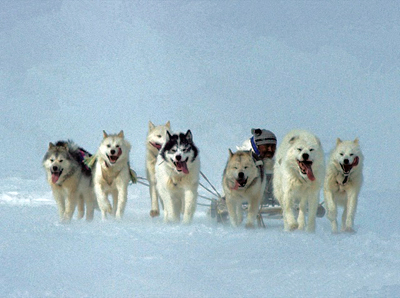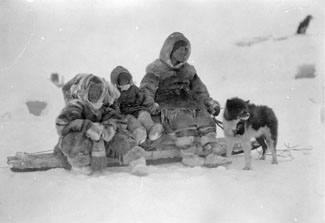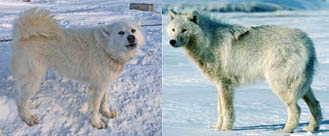Canis familiaris borealis
by Sue Hamilton
revised: December 2020
B. The Inuit Dog is not a wolf!
C. Dangerous confusion
B. Defining 'Purity'
C. Mistaken Identity: Promoting a breed vs. avoiding
extinction
D. The Belyaev Experiment
E. Summary
B. Recent history: The Inuit Dog in service to nations
2. War
3. Sovereignty
B. Below the tree line
B. Disease prevention and access to veterinary services
B. Behavior
C. Performance
D. The big picture
in Print
VIII. Acknowledgements
Appendix 1: Partial list of scientific publications about
the Inuit Dog
Appendix 2: Selected (alphabetical) list of other resources
with a focus on Inuit Dogs
Appendix 3: A small sampling of other resources of
interest
Navigating This Site
Index of articles by subject
Index of back issues by volume number
Search The Fan Hitch
Articles to download and print
Defining the Inuit Dog
Ordering Ken MacRury's Thesis
Our comprehensive list of resources
About The Fan Hitch
Talk to The Fan Hitch
The Fan Hitch home page
Editor-in-Chief: Sue Hamilton
Webmaster: Mark Hamilton
The Fan Hitch welcomes your letters, stories, comments and suggestions. The editorial staff reserves the right to edit submissions used for publication.
Contents of The Fan Hitch are protected by international copyright laws. No photo, drawing or text may be reproduced in any form without written consent. Webmasters please note: written consent is necessary before linking this site to yours! Please forward requests to Sue Hamilton, 55 Town Line Rd., Harwinton, Connecticut 06791, USA or mail@thefanhitch.org
This site is dedicated to the Inuit Dog as well as related Inuit culture and traditions. It is also home to The Fan Hitch, Journal of the Inuit Sled Dog.

Joshua Kango and his dog team in Iqaluit photo: Nick Newbery
A. The Inuit Dog's Place in the Natural World
- a class of domestic dogs that emerged as an ecotype within a specific ecological niche;
- largely the result of environmental adaptation, mostly under conditions of natural selection; influenced by human preferences and interference;
- fits the requirement of a specific human society living in a particular ecosystem.
The Primitive and Aboriginal Dog Society further defines a landrace as2:
… a naturally occurring type of dog ‘breed’ in
which the dogs are similar in appearance and usually
behaviour. They were created by natural selection for
their local environments (example: double vs single
coats depending on climate) and through only a small
amount of direct artificial selection. These are not
‘pure’ breeds in the modern sense of having a narrow
gene pool selected for some purpose, with no other
breeds allowed to be crossed in…Other landraces
maintain their general appearance and temperaments due
to only small genetic contributions of foreign dogs
being absorbed into the larger landrace, and also
because the traits of the foreign dogs are not
compatible and cannot be maintained under natural
selection…
The Inuit Dog is an aboriginal dog.3,4 Profoundly different from "cultured" breeds, they are still domestic but:
- have evolved by natural selection under conditions of free life and close interactions with people;
- are a unique piece of nature, time bound and place bound, most similar to zoological subspecies;
- are historically associated with ethnic groups and cultures;
- are the oldest and the only natural…dogs in existence.
Aboriginal but not primitive. The Inuit Dog was at one time considered a “primitive aboriginal landrace”. However, according to the Primitive and Aboriginal Dog Society6.
The only truly primitive dogs today are the Australian (and perhaps the Thai) Dingo and the New Guinea Singing Dog. These are the only dogs still living in a totally wild state. Although many have been tamed (as the first specimens brought to their native lands must have been) and so reproduced in and near aboriginal habitation, they have never been domesticated. They are the proto-domesticate ‘generalized’ dog and are, according to the available evidence, still close in morphology, and probably behaviour, to the dogs of about 15000 years ago.

Inuit Family, one dog only, 1926, Baker Lake, N.W.T.
Credit: L. T. Burwash
Dept. of Indian Affairs and Northern Dev. collection
Library and Archives Canada
B. The Inuit Dog is not a wolf!
Long-time arctic resident and Inuit Dog owner/breeder authority Ian Kenneth MacRury devoted a chapter to this subject in his masters thesis The Inuit Dog: Its Provenance, Environment and History. Many early explorers insisted that the Inuit Dog was part wolf and even to this day there are some who believe this to be true, going so far as perpetuate the myth that bitches in estrus were staked out by themselves to be bred by wolves. Inuit Dogs do share elements of the polar phenotype with arctic wolves. However, MacRury's research on skull and dentition measurements show no consistent hybridization. Furthermore, it is well known that wolves have a strong preference for killing dogs, loose or picketed. Also, biologists have explained that the differences in breeding and estrus cycles between wolves and dogs is not advantageous to the survival of hybrids in a polar environment. Personal communications with Inuit affirm that the willful practice of hybridization did not occur. Based on this body of information, it can be said that the Inuit Dog has no more wolf content than recognized breeds of Canis familiaris.

| Inuit
Dog, Iqaluit 2020 Photo: Jake Gearheard |
Arctic
Wolf
Photo: Corel |
C. Dangerous confusion
2 Primitive and Aboriginal Dog Society website definitions
3 Aboriginal Breeds In The Modern World
L. S. Bogoslovskaya Institute of Heritage, Moscow, Russia
Primitive and Aboriginal Dog Society Newsletter #16
4 The Concept of an Aboriginal Dog Breed
Vladimir Beregovoy
5 Evolutionary Changes in Domesticated Dogs: The Broken Covenant of the Wild, Part 1.
6 Primative and Aboeriginal Dog Society website definitions
7 Wolfdogs: Responsible or Irresponsible Breeding: Myths and Facts Explored; Sierra Milton, 2002
Northern Inuit: A Breed In The Making Or Designer-Dog Ripoff?; Silver Dragon, 2002
Wolf hybrids: The call of the semi-wild; Rick Sinnott; Alaska Dispatch, March 18, 2011